Home » Posts tagged 'supply chains' (Page 13)
Tag Archives: supply chains
COVID 19 and Our Food Supply
COVID 19 and Our Food Supply
Though food is still plentiful, with only temporary and localized shortages, the threat of the COVID 19 crisis to the food supply is considerable. There is no evidence thus far that the disease can be transmitted via food or packaging (though the virus apparently remains viable on plastic for 2 to 4 days). The real danger is that chains of supply will be undermined by both sickness and the pre-cautionary measure we take. Already we are seeing a contraction of food imports from abroad. But the danger extends to even our own local supply.
The safety of shoppers and workers at supermarkets is the first worry that public officials and the general public have expressed. But the food at market comes from somewhere; and that “somewhere” is peopled by a vast array of workers, starting with farmers and farm workers. Will we continue to have the workforce necessary to produce our food, and will they be able to do it in conditions of health and safety for themselves?
We don’t know, but there are troubling concerns. Take fresh produce, for example. Already pressed by acute labor shortages, farms large and small in places like the Central Coast of California have scrambled to provide job security to their workers. But they also depend during crucial harvest periods on temporary labor, and as the border tightened under the Trump administration the H2-A visa system has become important. Florida, Georgia, Washington, and California all depend upon a sizeable workforce from Mexico and the Caribbean under the system. But the virus has meant the closing of consulates in Mexico and elsewhere that process these visas. The labor crunch will come soon for producers of lettuce and strawberries on the Central Coast.
…click on the above link to read the rest of the article…
Coronavirus is bad: The economic fallout may be more deadly
Coronavirus is bad: The economic fallout may be more deadly
The immediate impacts of the Coronavirus worldwide and in the United States is horrific but the economic fallout after this pandemic ends may be more deadly.
Economic Fallout Caused By Coronavirus Will Be Far Worse
But the economic fallout and resulting impact on our fragile just-in-time supply-chain infrastructure from Covid-19 and the resulting austerity and deaths may easily surpass what was attributed to the 1930’s economic collapse in the U.S. during the Great Depression, and may last for a decade or more.
Few people realize that the United States imports a major percentage of what Americans need to maintain the lifestyles to which they have grown accustomed and depend. And many of those imports have already slowed, significantly. It’s like pushing a huge boulder uphill; the moment you lose momentum, it can roll-back and right over the top of you.
Excerpt from Foreign Policy Magazine:
“Beyond the immediate treatment of those infected with coronavirus, however, Western governments have almost universally shut down rather than ramped up production. As one financial analyst pointed out, “lockdown economics” is in many ways the exact opposite of the wartime economics of total mobilization.
During both world wars, economic mobilization enrolled unprecedentedly large groups of male and female workers in mass production. The coronavirus’s disruption of supply chains and the social distancing measures of today, however, are currently putting millions of employees in the manufacturing and service sectors out of work.“
Sorting Out The Pandemic May Not End The Crises
Folks that loiter too long in cities in the hopes that sorting out the pandemic will end the crises may be in for a very rude, and potentially deadly surprise (time is already a critical aspect for effective tactics).
…click on the above link to read the rest of the article…
China Suffers Economic Double-Whammy As Current Global Demand Collapse Follows Earlier Supply Crash
China Suffers Economic Double-Whammy As Current Global Demand Collapse Follows Earlier Supply Crash
As the first quarter is about to close, many Chinese factories are still operating below full capacity, have been gradually ramping up production over the last several weeks as government data suggests the country’s pandemic curve has flattened.
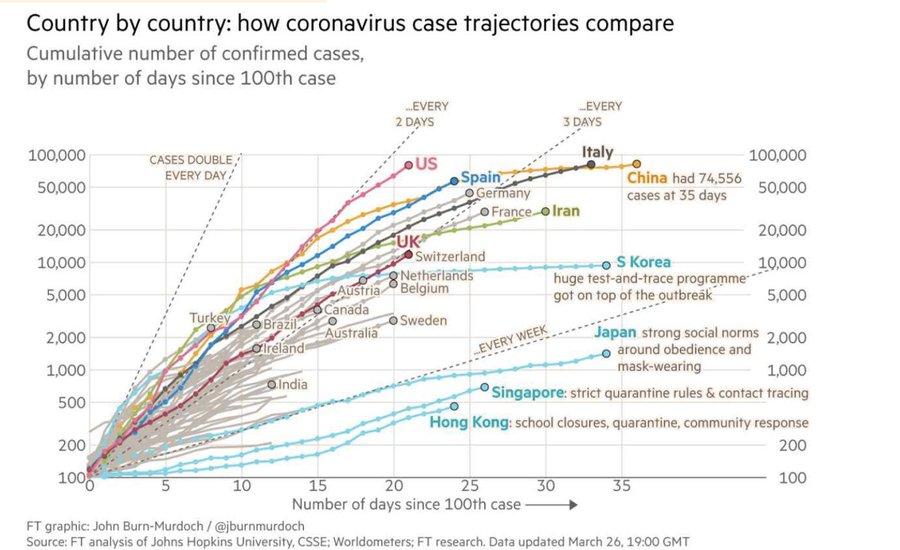
But as Bloomberg notes, there is a serious problem developing, one where the virus crisis is locking down the Western Hemisphere, has resulted in firms from Europe and the US to cancel their Chinese orders en masse, triggering the second shockwave that is starting to decimate China’s industrial base.
A manager from Shandong Pangu Industrial Co. told Bloomberg that 60% of their orders go to Europe. In recent weeks, manager Grace Gao warned that European clients are requesting orders to be delayed or canceled because of the virus crisis unfolding across the continent.
“It’s a complete, dramatic turnaround,” Gao said, estimating that sales in April to May could plunge by 40% over the prior year. “Last month, it was our customers who chased after us checking if we could still deliver goods as planned. Now it’s become us chasing after them asking if we should still deliver products as they ordered.”
A twin shock has emerged, one where China shuttering most of its industrial base from mid-January through early March, generated a supply shock. Now, as those Chinese firms add capacity, expecting to be met with a surge in demand from Western companies, that is not the case and is resulting in a demand shock.
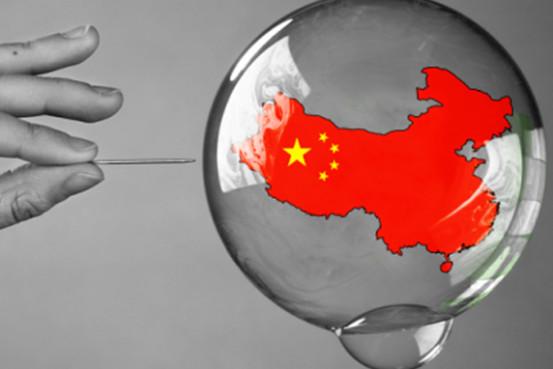
“It is definitely the second shockwave for the Chinese economy,” said Xing Zhaopeng, an economist at Australia & New Zealand Banking Group. The pandemic across the world “will affect China manufacturing through two channels: disrupted supply chains and declining external demand.”
…click on the above link to read the rest of the article…
Don’t Look Now But The People Responsible For The World’s Food Supply Are Starting To Get Sick
Don’t Look Now But The People Responsible For The World’s Food Supply Are Starting To Get Sick
Sanderson Farms, a large poultry manufacturer and Smithfield Foods, the world’s largest pork producer, have both reported their first couple of positive cases of coronavirus.
This raises the obvious question: what happens when people critical to the world’s food supply start to fall ill?
As of now, there has been no such disruption – but it is beginning to morph into a massive threat, Bloomberg notes, with workers in close quarters preparing and processing food globally. Aside from the obvious threat of food not making it to consumers, things like fruits may also wind up rotting in fields if there aren’t enough workers to pick and cultivate them.
Al Stehly, who operates a farm-management business in California’s North San Diego County said: “If we can’t flatten the curve, then that is going to affect farmers and farm laborers — and then we have to make choices about which crops we harvest and which ones we don’t. We hope no one gets sick. But I would expect some of us are going to get the virus.”
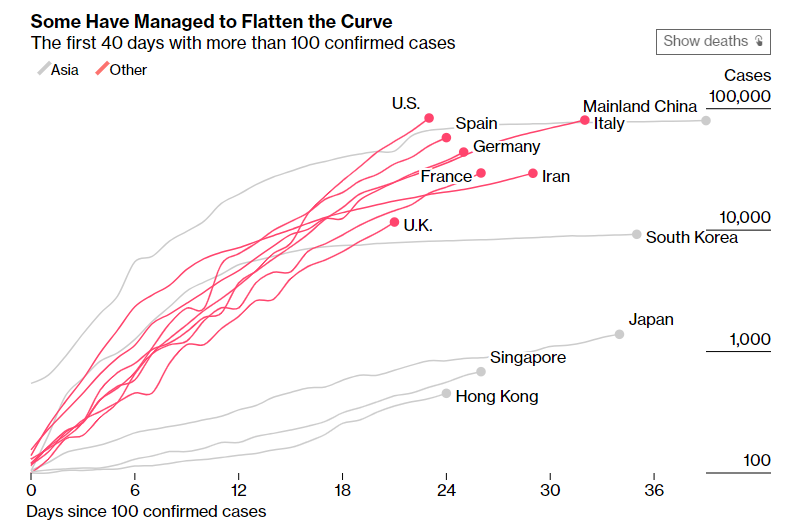
And to clarify, it’s not the food itself that causes the threat of the virus. It’s the supply chain disruption that the virus can cause with workers.
Sanderson was lucky in the sense that their one worker only worked at a small table by themselves. But other infections in the industry, where workers are closer together, could wreak more havoc. At some beef plants, workers are “elbow to elbow” and despite the employees wearing protective gear, there still remains risk of contagion.
Dave MacLennan, chief executive officer of Cargill Inc., the world’s largest agricultural commodities trader said: “One of our beef plants feeds 22 million people per day, so it’s vital that these plants stay open.”
…click on the above link to read the rest of the article…
“Rolling Natural Disaster” – COVID-19 Supply Chain Shock Could Trigger Global Depression
“Rolling Natural Disaster” – COVID-19 Supply Chain Shock Could Trigger Global Depression
Evidence of creaking global supply chains is fast emerging, at risk of triggering the next global depression amid the COVID-19 pandemic.
A supply chain crisis that began earlier this year, one that we warned from the very start, has now spread across Asia to the Middle East to Europe, and now to the Americas.
“This is kind of a rolling natural disaster,” said Ethan Harris, head of global economic research at Bank of America. “In terms of the impact on global production, the shutdown outside of China will likely become bigger than the impact from China.”
Harris warned that the shock to global supply chains is deep and broad and could easily last through the next quarter. He estimates that factory shutdowns in many regions could last until May.
New Covid-19 advert urges protection of elderly
He describes a twin shock, one where a supply chain shock has been combined with a demand shock, culminating into a perfect storm, will likely tip many countries into recession, if not depression during the second quarter.
Bloomberg piecemeals current supply chain disruptions seen across the world:
Apple has had the most exposure to a China shutdown, with manufacturing plants in the country still operating well below full capacity in late March. Virus-related closings have hammered several of the company’s key suppliers operating in South Korea, Italy, Germany, and Malaysia.
In late January, Freeport-McMoRan’s CEO Richard Adkerson warned that the virus outbreak in China is a “real black swan event” for the global economy. The company’s mining operations in Peru have recently been halted. Other mining facilities in Chile, Canada, and Mongolia have also been shuttered.

Across Europe, Airbus and Volkswagen AG have closed production plants amid severe virus outbreaks in Italy, Spain, Germany, France, Switzerland, and the UK. Major transportation networks on the continent have come to a standstill as nonessential travel has been banned in many regions.
…click on the above link to read the rest of the article…
COVID-19 And Global Supply Chains: Watch Out For Bullwhip Effects
COVID-19 And Global Supply Chains: Watch Out For Bullwhip Effects
In an earlier piece on the COVID-19 (Wuhan Coronavirus), I talked about how supply chain disruptions seemed to be occurring in slow-motion. A recent report from the Journal of Commerce warned of an imminent shortage of shipping containers in inland U.S. locations. How could these things be connected, and are we at risk of supply chain oscillations, often referred to as a bullwhip effect?
The virtual shutdown of commercial traffic in China has had a huge impact on global shipping. With the extended Lunar New Year shutdown, container shipping carriers have announced a large number of “blank sailings” – an industry euphemism for “we cancelled that voyage.” That’s completely rational, as nobody was sending trucks with outbound cargo to the big Asian container terminals. I had taken a class to visit the giant Yantian International Container Terminal in Shenzhen in January, and they told us they handled 20,000 trucks on a typical day. When I checked it last week, there was little visible traffic. With much of the country in lockdown and factories struggling to get production restarted, this was not a surprise.

For global supply chains that go by ocean, there is a built in time lag attributable to ship transit times. Container ships carrying exports that left China before the outbreak are only recently discharging cargo at destinations. We saw the Ebba Maersk loading at Yantian in Shenzhen on January 5. It didn’t make it to Rotterdam until February 2, and at last check it was at the Thames Port in the United Kingdom. That meant 27 days to reach the first port of call in Europe. Yantian (Shenzhen) to Long Beach, California might take 14 or 15 days, and a rail connection to the Midwest might take five more days.
…click on the above link to read the rest of the article…
Former Supermarket Boss Warns of Potential Coronavirus “Food Riots,” Army Patrols
Former Supermarket Boss Warns of Potential Coronavirus “Food Riots,” Army Patrols
Grocery stores may have to take drastic measures.

Former Tesco supply chain director Bruno Monteyne warns that a large scale outbreak of coronavirus in the UK could lead to “food riots,” requiring the army to be used to guard supermarkets.
Monteyne said that supermarkets would have to resort to drastic measures and revert to “feed the nation status” under a worse case scenario.
He also cautioned that grocery stores would have trouble stocking shelves and delivering goods if their employees decided to self-isolate.
“Yes, it will be chaotic (and expect pictures of empty shelves),” wrote Mr Monteyne, “but the industry will reduce complexity to keep the country fed.”
He said that the army may need to be drafted in to guard stores and prevent disorder.
UK Health Secretary Matt Hancock said he was “confident” food supplies would not run out and that there was “absolutely no need” to panic-buy.
Hancock also claimed that supermarkets could deliver food to coronavirus patients who had self-isolated, although this claim was immediately put in doubt by one supermarket executive, who said he was “baffled” by the suggestion.
“Matt Hancock has totally made up what he said about working with supermarkets. We haven’t heard anything from government directly,” the executive said, adding, “I’m not sure the government can guarantee all food supply in all instances.”
A source at another supermarket told the BBC that there had been no detailed planning involving government departments about “ensuring uninterrupted food supplies.”
Panic buying continued across the UK today, with supermarket shelves of goods like hand sanitizer, toilet paper and medicine.
The number of coronavirus cases in the UK has now reached 163, with two deaths.
Destruction By Definition
Destruction By Definition
Major U.S. stock market indexes yo-yoed about all week. On Monday, panic selling from last week turned to panic buying. Decades of Fed intervention have conditioned stock market investors to step in front of semi-trucks to scoop up nickels.
The Dow Jones Industrial Average (DJIA) jumped 1,290 points. This marked its biggest-ever single day gain in terms of points. Can the economic destruction wrought by coronavirus containment really be overcome with what former New York Fed President, Benjamin Strong, once called stock market “coup de whiskey?” We doubt it.
But we are fairly confident Fed stimulus will have the offensive consequence of widening the gap between sky high asset prices and weak economic fundamentals. Fed Chairman Powell certainly understands this. Nonetheless, on Tuesday, he went forward with the dirty deed.
After an early morning teleconference with various G7 poohbahs, Powell cut the federal funds rate by 50 basis points. This took the Fed’s target range to between 1 and 1.25 percent. As far as we can tell, Powell’s dirty deed achieved the exact opposite of its intent.
U.S. stock market indexes didn’t go up. Rather, they went down. In fact, they went down a lot. The DJIA, for example, gave back 785 points. Here’s why…
The Fed’s rate cut was an act of fear. Investors smelled it out and circled like a pack of wild hyenas. Powell may be able to expand the supply of money and credit. But he can’t make up for the economic destruction of a global economy that’s grinding to a halt to stem the spread of coronavirus. Cutting rates 50 basis points won’t cut it.
“This Sucker’s Going Down”
Bull markets, like myths and legends, die hard in America. By Wednesday, the bulls were back at it…bidding up share prices like 17th century tulip bulbs. The DJIA, baited by promises for fiscal stimulus, jumped 1,173 points – back above 27,000.
…click on the above link to read the rest of the article…
Globalization and Our Precarious Medical Supply Chains
Globalization and Our Precarious Medical Supply Chains
The grave risks and dangers in the process of worldwide out-sourcing and so-called globalization of the past 30 years or so are becoming starkly clear as the ongoing health emergency across China threatens vital world supply chains from China to the rest of the world. While much attention is focused on the risks to smartphone components or auto manufacture via supplies of key parts from China or to the breakdown of oil deliveries in the last weeks, there is a danger that will soon become alarmingly clear in terms of global health care system.
If the forced shutdown of China manufacture continues for many weeks longer, the world, could begin to experience shortages or lack of vital medicines and medical supplies. The reason is that over the past two decades much of the production of medicines and medical supplies such as surgical masks have been outsourced to China or simply made in China by Chinese companies at far cheaper prices, forcing Western companies out of business.
Sole source China
According to research and US Congressional hearings, something like 80% of present medicines consumed in the United States are produced in China. This includes Chinese companies and foreign drug companies that have outsourced their drug manufacture in joint ventures with Chinese partners. According to Rosemary Gibson of the Hastings Center bioethics research institute, who authored a book in 2018 on the theme, the dependency is more than alarming.
Gibson cites medical newsletters giving the estimate that today some 80% of all pharmaceutical active ingredients in the USA are made in China. “It’s not just the ingredients. It’s also the chemical precursors, the chemical building blocks used to make the active ingredients. We are dependent on China for the chemical building blocks to make a whole category of antibiotics… known as cephalosporins. They are used in the United States thousands of times every day for people with very serious infections.”
…click on the above link to read the rest of the article…
“Ground Zero For Trade” – Port Of Long Beach Warns Of Shipping Slump From China
“Ground Zero For Trade” – Port Of Long Beach Warns Of Shipping Slump From China
Investors are grossly underestimating the potential economic impact of Covid-19 as the first signs of China’s supply chain meltdown are now washing ashore on US West Coast ports.
The Port of Long Beach, the second-largest containerized port in the US, has had two top officials warn in the last several weeks of chilling effects of supply chain disruptions from China.
Last week, the Deputy Executive Director of Administration and Operations for the Port of Long Beach Noel Hacegaba warned China’s economic paralysis led to the increase of blank sails between China and the US. He said port activity plunged in January and February, with expected weakness to continue through March.
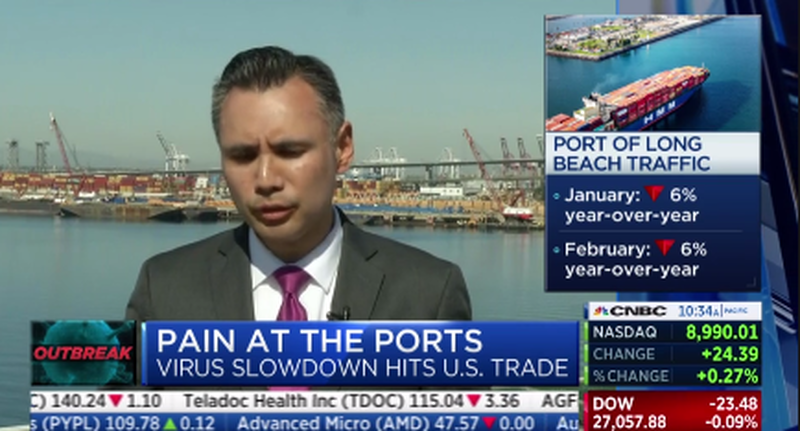
Hacegaba said the slowdown at Long Beach is starting to hit the local economy around the port. He said it could only be a matter of time before it triggers a broader slowdown in the region, and even maybe in the overall US economy.
As we’ve noted in many pieces of creaking global supply chains fast emerging in China and spreading outwards, Deutsche Bank’s senior European economist Clemente Delucia last month pointed out in a report titled “The impact of the coronavirus: A supply-chain analysis” that the US is overly exposed to a crashing China economy.
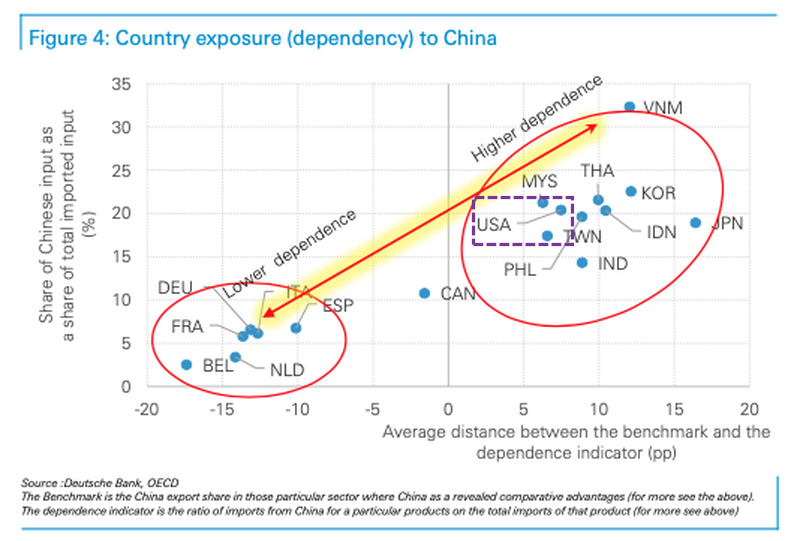
As for the second Long Beach official, Bloomberg quoted Mario Cordero, executive director of the port, who said cargo volumes are expected to slump 9% YoY in February due to declining shipments from China.
Cordero said February’s YoY loss is nearly double of 2019’s decline of 5.4%, which has already resulted in a 50% reduction in labor at the port. He said the East Asia shipping route accounts for 90% of shipments through the port.
Goldman Issues Shocking Warning On Systemic Threat From Supply-Chain Collapse
Goldman Issues Shocking Warning On Systemic Threat From Supply-Chain Collapse
Having desperately avoided any discussion of a worst-case coronavirus scenario – or frankly any scenario that did not involve all time highs for stocks – for over a month, suddenly the market is obsessing with what a complete paralysis of China could mean for the world, not just in terms of millions in small and business companies shuttering and the financial sector collapsing under the weight of trillions in bad loans, but specifically how global supply chain linkages could cripple commerce across the world as corporations suddenly find themselves unable to find economic alternatives if China indeed goes dark.
However, as long-time readers may recall, the problem with trying to model supply chains shocks, especially in today’s “Just In Time” world, is that this task is virtually impossible as such a simulation very quickly reaches impossible complexity, something we first described in 2012 in our article “A Study In Global Systemic Collapse“, which referred to the FEASTA article titled “‘Trade-Off: Financial System Supply-Chain Cross-Contagion” which showed that contagion within supply chains could quickly lead to wholesale, systemic collapse due to non-linear bifurcations between sequential phase states.
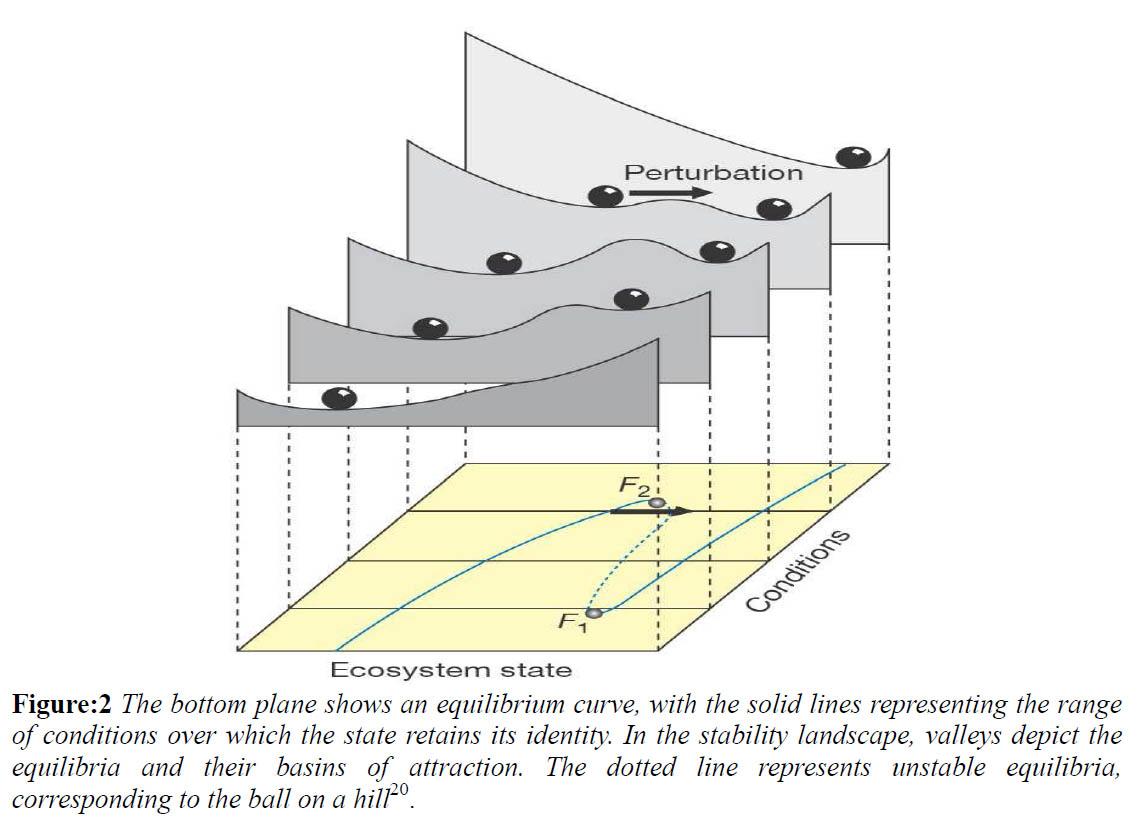
Not for nothing, this is how we described the study back in 2012: “think of the attached 78-page paper as Nassim Taleb meets Edward Lorenz meets Malcom Gladwell meets Arthur Tansley meets Herman Muller meets Werner Heisenberg meets Hyman Minsky meets William Butler Yeats, and the resultant group spends all night drinking absinthe and smoking opium, while engaging in illegal debauchery in the 5th sub-basement of the Moulin Rouge circa 1890.”
And while there was far more in the report, one section was notable – the one discussing how relentless central bank intervention has made the global system far more brittle, or as Taleb would call it, extremely not anti-fragile:
…click on the above link to read the rest of the article…
Supply Chain Disruptions Impact on Global Growth
Supply Chain Disruptions Impact on Global Growth
In a previous post, we mentioned that stagflation is a risk that central planners are ignoring. However, this risk is not just an isolated challenge focused on economies like Mexico, India or Argentina. Even in countries like Germany and Japan the trend of inflation, particularly in non-replicable goods, is diverging from economic growth. Inflation is picking up, while growth is slowing down.
Central banks continue to pump liquidity to disguise the rising risks to the global economy, but the coronavirus epidemic is showing to investors three important lessons:
Containment of the epidemic is taking significantly more time than what many market participants estimated. Calls fro a rapid recovery that would not only offset the first-quarter impact but improve it, are disproved.
The impact on supply chains is significantly larger than most analysts expected. China is now 17% of the global economy and provinces that count for 89% of the country’s exports remain in lockdown.
Global excess capacity is a mitigating factor on rising inflation only for replicable and highly competitive goods. There is clearly ample capacity to offset supply chain disruptions in energy commodities, metals, and industrial goods but there are severe problems surfacing in sectors that are very dependent on Chinese supply, particularly auto parts and technology components.
Market participants started to realize last week that the coronavirus effect was not going to be a two-month issue that would be followed by strong growth. In a recent PriceWaterhouse Coopers report, it showed that the global impact could reach at least 0.7% of GDP. This estimate uses Eric Toner´s infected and casualty estimates (John Hopkins Center for Health Security) and the economic impact using McKibbins & Lee methodology (the ones that estimated the SARS impact).
…click on the above link to read the rest of the article…
Global Crop Failures Continue: In Australia This Is Going To Be The WORST HARVEST Ever Recorded
Global Crop Failures Continue: In Australia This Is Going To Be The WORST HARVEST Ever Recorded
Global food production is being hit from seemingly every side. Thanks to absolutely crazy weather patterns, giant locust armies in Africa and the Middle East, and an unprecedented outbreak of African Swine Fever in China, a lot less food is being produced around the world than originally anticipated. Even during the best of years we really struggle to feed everyone on the planet, and so a lot of people are wondering what is going to happen as global food supplies become tighter and tighter. The mainstream media in the United States is so obsessed with politics right now that they haven’t been paying much attention to this emerging crisis, but the truth is that this growing nightmare is only going to intensify in the months ahead.
In Australia, conditions have been extremely hot and extremely dry, and that helped to fuel the horrific wildfires that we recently witnessed.
And everyone knew that agricultural production in Australia was going to be disappointing this year, but it turns out that it is actually going to be the worst ever recorded…
Australia’s hottest and driest year on record has slashed crop production, with summer output expected to fall to the lowest levels on record, according to official projections released Tuesday.
The country’s agriculture department said it expects production of crops like sorghum, cotton and rice to fall 66 percent — the lowest levels since records began in 1980-81.
The continent of Australia is considered to be one of the breadbaskets of the world. According to the U.S. Department of Agriculture, in 2018/19 Australia exported over 9 million tons of wheat to the rest of the world.
But thanks to relentless crop failures, Australia has started to import wheat, and that is likely to continue for the foreseeable future.
So instead of helping to feed the rest of the world, Australia is now relying on the rest of us to help feed them.
And what is happening this year didn’t just barely break the old records. In fact, one senior economist says that this will be the worst summer crop production the country has ever seen “by a large margin”…
‘Weak Start To The Year’ – Maersk Warns Paralyzed Chinese Factories To Damage Global Economy
‘Weak Start To The Year’ – Maersk Warns Paralyzed Chinese Factories To Damage Global Economy
A.P. Moller-Maersk A/S, the world’s largest container shipping company, warned Thursday that the Covid-19 outbreak in China, and quickly spreading across the world, would hit earnings this year.
Maersk said factories in China are currently operating at 50-60% of capacity because the economy has ground to a halt.
Maersk reported an unexpected loss in the fourth quarter of $72 million from a profit of $46 million a year earlier. The shipper is a barometer of global trade, said revenues declined 5.6% to $9.67 billion, missing expectations of $9.4 billion, due mostly to a decline in container shipping.
Shipping volumes in both East to West and North to South routes were lower amid several years of front-loading by corporations ahead of President Trump’s tariffs. Lower demand was seen across Europe, Latin America, the US, and across Asia Pacific countries last quarter.
The shipper said 2020 guidance is filled with many uncertainties because the deadly virus can still spread outside of China and impact the global economy.
“As factories in China are closed for longer than usual in connection with the Chinese New Year as a result of the COVID-19, we expect a weak start of the year,” Maersk warned.
Maersk’s warning comes as China’s economy remains completely paralyzed, expected to slow global trade in goods in the coming months and produce increased trade uncertainties, the World Trade Organization (WTO) said this week.
“The slow start could be dampened further,” the WTO said in the report, “by global health threats and other recent developments in the first few months of the year, which are not yet accounted for in the barometer’s best-available historical data.”
…click on the above link to read the rest of the article…





